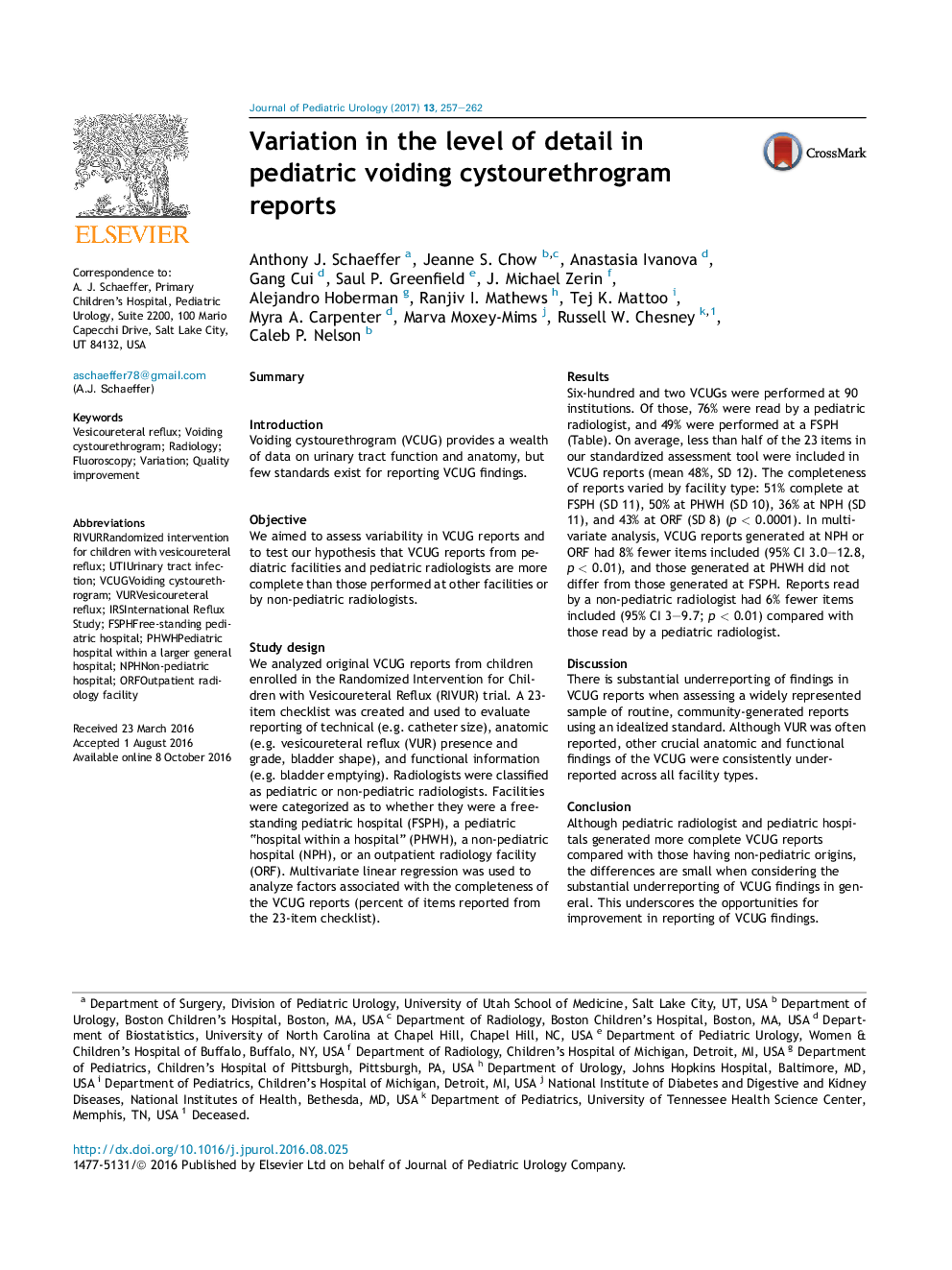| Article ID | Journal | Published Year | Pages | File Type |
|---|---|---|---|---|
| 5718580 | Journal of Pediatric Urology | 2017 | 6 Pages |
SummaryIntroductionVoiding cystourethrogram (VCUG) provides a wealth of data on urinary tract function and anatomy, but few standards exist for reporting VCUG findings.ObjectiveWe aimed to assess variability in VCUG reports and to test our hypothesis that VCUG reports from pediatric facilities and pediatric radiologists are more complete than those performed at other facilities or by non-pediatric radiologists.Study designWe analyzed original VCUG reports from children enrolled in the Randomized Intervention for Children with Vesicoureteral Reflux (RIVUR) trial. A 23-item checklist was created and used to evaluate reporting of technical (e.g. catheter size), anatomic (e.g. vesicoureteral reflux (VUR) presence and grade, bladder shape), and functional information (e.g. bladder emptying). Radiologists were classified as pediatric or non-pediatric radiologists. Facilities were categorized as to whether they were a free-standing pediatric hospital (FSPH), a pediatric “hospital within a hospital” (PHWH), a non-pediatric hospital (NPH), or an outpatient radiology facility (ORF). Multivariate linear regression was used to analyze factors associated with the completeness of the VCUG reports (percent of items reported from the 23-item checklist).ResultsSix-hundred and two VCUGs were performed at 90 institutions. Of those, 76% were read by a pediatric radiologist, and 49% were performed at a FSPH (Table). On average, less than half of the 23 items in our standardized assessment tool were included in VCUG reports (mean 48%, SD 12). The completeness of reports varied by facility type: 51% complete at FSPH (SD 11), 50% at PHWH (SD 10), 36% at NPH (SD 11), and 43% at ORF (SD 8) (p < 0.0001). In multivariate analysis, VCUG reports generated at NPH or ORF had 8% fewer items included (95% CI 3.0-12.8, p < 0.01), and those generated at PHWH did not differ from those generated at FSPH. Reports read by a non-pediatric radiologist had 6% fewer items included (95% CI 3-9.7; p < 0.01) compared with those read by a pediatric radiologist.DiscussionThere is substantial underreporting of findings in VCUG reports when assessing a widely represented sample of routine, community-generated reports using an idealized standard. Although VUR was often reported, other crucial anatomic and functional findings of the VCUG were consistently underreported across all facility types.ConclusionAlthough pediatric radiologist and pediatric hospitals generated more complete VCUG reports compared with those having non-pediatric origins, the differences are small when considering the substantial underreporting of VCUG findings in general. This underscores the opportunities for improvement in reporting of VCUG findings.Table. Summary of population and results.CharacteristicNo. of VCUG reports analyzed602Gender of participants Male49 (8.1%) Female553 (91.9%)Median age in months at VCUG (IQR)11 (5,30)VCUG read bya Pediatric radiologist459 (76.2%) Non-pediatric radiologist134 (22.3%)VCUG performed atb FSPH297 (49.3%) PHWH184 (30.6%) NPF87 (14.5%) ORF33 (5.5%)Overall frequency of item being reported (8 items selected from 23 total) Indication from procedure557 (93) Presence of VUR601 (99) Grade of VUR585 (97) Cyclic study95 (16) Complete bladder emptying429 (71) Bladder appearance517 (86) Urethra appearance447 (74) Delayed images assessing upper tracts151 (25)FSPH = free-standing pediatric hospital; NPH = non-pediatric hospital; ORF = outpatient radiology facility; PHWH = pediatric 'hospital within a hospital'; VCUG = voiding cystourethrogram; VUR = vesicoureteral reflex.aNine reports lacked information to identify the radiologist.bOne facility type was unknown.
